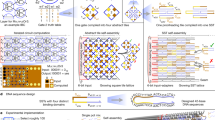Abstract
Whiplash PCR (WPCR; Hagiya et al., in Rubin H, Woods DH (eds) DNA based computers, vol III, pp 55–72. American Mathematical Society, Providence, RI, 1999) is a novel technique for autonomous molecular computation where a state machine is implemented with a single stranded DNA molecule and state transition is driven by polymerase and thermal cycles. The primary difference between WPCR computation and other forms of molecular computing is that the former is based on local, rather than global rules. This allows many (potentially distinct) WPCR machines to run in parallel. However, since each state transition requires a thermal cycle, multi-step WPCR machines are laborious and time-consuming, effectively limiting program execution to only a few steps. To date, no WPCR protocol has been developed which is both autocatalytic (self-executing) and isothermal (with no change in temperature). In this paper, we describe some isothermal and autocatalytic protocols that use a combination of strand displacement and DNA polymerization events. Our designs include (1) a protocol where transition rules cannot be reused in subsequent computing (2) a protocol where rules can be reused using an auxiliary strand displacement event but does not prevent back-hybridization (an event responsible for limiting the program execution to only a few state transitions before the machine stalls), (3) a reusable rule protocol that prevents back-hybridization. Furthermore, we show that the third machine which gets rid of thermal cycles and still prevents back-hybridization, is computationally equivalent to the original WPCR machine. We also compute the state transition likelihood and the corresponding rate in this protocol. Finally we present a DNA sequence design of a 3-state isothermal and reactivating WPCR machine along with an experimental verification plan.











Similar content being viewed by others
Notes
Although Fig. 9 is very complex, it should be remembered that it is essentially a cross between Fig. 7 and 8. The hairpins in the computational rewrite rule and the 3′ end of the machine are taken from Fig. 8 while the rest of the protocol comes from Fig. 7. Keeping this in mind, the reaction pathway in Fig. 9 is much easier to understand.
To be consistent with the description of the original WPCR machine we use only empty input string for the simulation of this finite state machine. It should be remembered, if the original finite state machine can be represented as a directed acyclic graph, we can incorporate input as part of the transition rules and the initial input symbol as part of the current state at the beginning of program execution as described in Sect. 2.
Abbreviations
- PCR:
-
Polymerase chain reaction
- WPCR:
-
Whiplash polymerase chain reaction
- DNA:
-
Deoxyribo nucleic acid
- ds-DNA:
-
Double stranded deoxyribo nucleic acid
- PNA:
-
Peptide nucleic acid
- IR-WPCR:
-
Isothermal reactivating Whiplash polymerase chain reaction
- FRET:
-
Fluorescence resonance energy transfer
- bis-PNA:
-
Bi-specific peptide nucleic acid
References
Benenson Y, Paz-Elizur T, Adar R, Keinan E, Livneh Z, Shapiro E (2001) Programmable and autonomous computing machine made of biomolecules. Nature 414:430–434
Goodman R, Berry R, Turberfield A (2004) The single-step synthesis of a DNA tetrahedron. Chem Commun 12:1372–1373
Hagiya M, Arita M, Kiga D, Sakamoto K, Yokoyama S (1999) Towards parallel evaluation of boolean μ formulas with molecules. In: Rubin H, Woods DH (eds) DNA based computers, vol III, pp 55–72. American Mathematical Society, Providence, RI
Hames BD, Higgins SJ (1995) Gene probes, vol 2. Oxford University Press, Oxford
Komiya K, Yamamura M, Rose J (2008) Experimental validation of signal dependent operation in Whiplash PCR. DNA 14, LNCS
Majumder U, LaBean T, Reif J (2008) Activatable tiles for compact, robust programmable assembly and other applications. DNA 13. LNCS 287:195–214
Mathieu F, Liao S, Kopatscht J, Wang T, Mao C, Seeman N (2005) Six-helix bundles designed from DNA. Nano Lett 5:661–665
Matsuda D, Yamamura M (2002) Cascading Whiplash PCR with a nicking enzyme. Lect Notes Comput Sci 2568:38–46
Nishikawa A, Hagiya M (1999) Towards a system for simulating DNA computing with Whiplash PCR. In: Angeline PJ, Michalewicz Z, Schoenauer M, Yao X, Zalzala A (eds) Proceedings of the congress on evolutionary computation, vol 2, pp 960–966. Mayflower Hotel, Washington DC, USA. IEEE Press, New York
Rose J, Komiya K, Yaegashi S, Hagiya M (2006) Displacement Whiplash PCR: optimized architecture and experimental validation, DNA 12. Lect Notes Comput Sci 4287:393–403
Rose JA, Deaton RJ, Hagiya M, Suyama A (2001) Pna-mediated Whiplash PCR. Lect Notes Comput Sci 2340:104 – 116
Sahu S, LaBean T, Reif JH (2008) A DNA nanotransport device powered by polymerase phi 29. Nano Lett 8(11):3870–3878
Sakamoto K, Kiga D, Komiya K, Gouzu H, Yokoyama S, Ikeda S, Sugiyama H, Hagiya M (1999) State transitions by molecules. Biosystems 52:81–91
Saturno J, Blanco L, Salas M, Esteban J (1995) A novel kinetic analysis to calculate nucleotide affinity of proofreading DNA polymerases. J Bio Chem 270(52):31235–31243
Seeman N (1990) De novo design of sequences for nucleic acid structural engineering. J Biomol Struct Dyn 8:573–581
Shih W, Quispe J, Joyce G (2004) A 1.7-kilobase single-stranded DNA that folds into a nanoscale octahedron. Nature 427:618–621
Soloveichik D, Winfree E (2005) The computational power of Benenson automata. Theor Comput Sci 244:279–297
Thompson BJ, Camien MN, Warner RC (1976) Kinetics of branch migration in double-stranded DNA. Proc Natl Acad Sci USA 73(7):2299–2303
Tyagi S, Kramer F (1996) Molecular beacons: probes that fluoresce upon hybridization. Nat Biotechnol 14(3):303–308
Winfree E (1998a) Simulation of computing by self-assembly. Technical report 1998.22, Caltech
Winfree E (1998b) Whiplash PCR for o(1) computing. Technical report 1998.23, Caltech
Winfree E, Liu F, Wenzler L, Seeman N (1998) Design and self-assembly of two-dimensional DNA crystals. Nature 394(6693):539–544
Acknowledgments
This work is supported by NSF EMT NANO grant CCF-0829798 and CCF-0523555.
Author information
Authors and Affiliations
Corresponding author
Rights and permissions
About this article
Cite this article
Reif, J.H., Majumder, U. Isothermal reactivating Whiplash PCR for locally programmable molecular computation. Nat Comput 9, 183–206 (2010). https://doi.org/10.1007/s11047-009-9148-6
Received:
Accepted:
Published:
Issue Date:
DOI: https://doi.org/10.1007/s11047-009-9148-6




